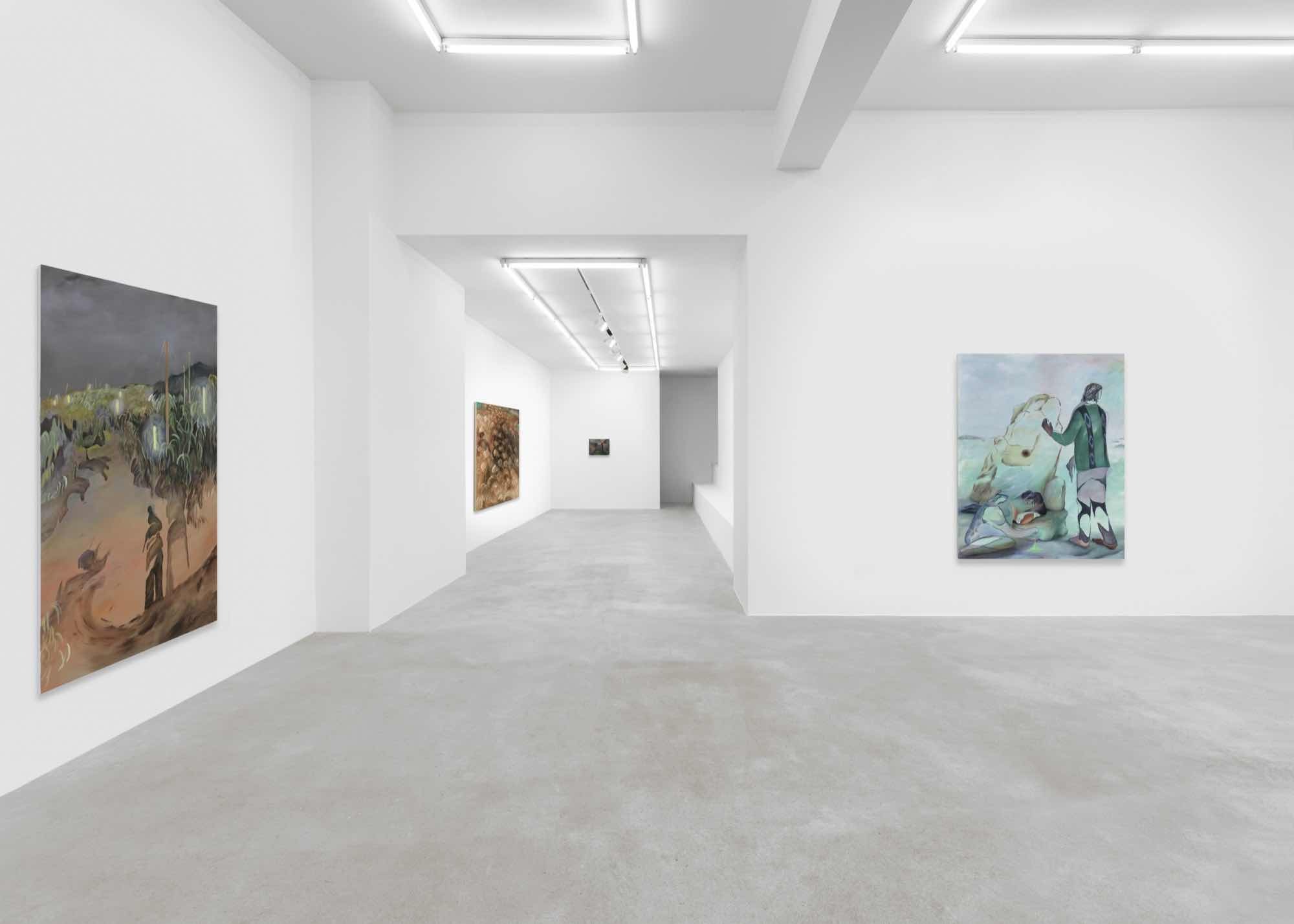Hiroka Yamashita
Fūdo
12 Mar - 23 Apr 2022
Tanya Leighton, Berlin is pleased to announce ‘Fūdo’ by Hiroka Yamashita, a series of new landscape paintings in which the artist ruminates on the formative relationship between people and their ancestral land. In recent years, Yamashita has gained attention for her otherworldly depictions of Japan in which ghostly figures dissolve into forest mists, windswept fields, and twilight skies. Yamashita’s world is consumed by a haze of sap green, teal, violet, turquoise, and ochre, creating an atmosphere appropriate for the exhibition’s title, which can be crudely translated to ‘climate’. But fūdo has a complicated meaning in Japanese that cuts across history, politics, and philosophy. Literally ‘wind/earth’, fūdo can be used to describe the culture of a region. Fūdoki, a close derivative, for instance, denotes the ancient royal records that surveyed the country’s various provinces – their terrain, customs, and oral traditions. And in more recent memory, fūdo conjures another significant association to which Yamashita wishes to draw attention, namely the 20th-century philosopher Tetsuro Watsuji (1889–1960).
“No doubt no-one could deny that in the course of the association between man and nature, natural characteristics come to be exemplified as features of man’s life. When man first discovered himself standing in confrontation with nature—the world beyond him—man-made nature’s features his own”, writes Watsuji in his widely influential book ‘Fūdo’ (1935). He adds, “This does not mean that natural phenomena gave rise to distinctive effects on the soul of man as if it were a piece of blank paper, for man did not and could not live thus in isolation from his natural environment”. In other words, the spaces where humans settle not only shape their practical lives but also condition their common sense of propriety and personhood.
Watsuji’s work plots a foundational relationship between ecology and morality, nature and virtue, and it is to this idea that Yamashita’s work turns into an exploration of her own relationship to place, identity, and spirituality. The scenes that appear in her work are drawn from the artist’s regular walks in and around her home of Okayama. Onto such sites, Yamashita projects her imaginative associations that tap into her knowledge of local customs, folklore, and geographic features, as if—to use the artist’s own words—the painter is a mediator that carries forward an ancient oral tradition. In a country that is subject to earthquakes, tsunamis, monsoon floods, volcanoes, and forest fires, Yamashita reminds us that a spiritual relationship with nature entails a deep acceptance of both its blessings and disasters. Viewed from this vantage, it may be clarifying to think of Yamashita’s work as a kind of fūdoki in its own right.
Susuki Grass (2021), Lookout with Large Rock (2021), or Peach Farm at Night (2021) could be seen as reports on the local character of various regions, their features, lifestyles, and stories. However, unlike the tactical concerns of royal fūdoki, Yamashita’s reports feel wholly invested in capturing a site’s impression on the senses, such as the feel of grass, the smell of ash, the weight of fog, the turning of the sky, and the sound of cicadas. Like the atmosphere from which the artist takes her inspiration, Yamashita’s paintings soak the skin of all particulars until all their qualities are sapped and bled into a haze that offers a gestalt of a place.
“No doubt no-one could deny that in the course of the association between man and nature, natural characteristics come to be exemplified as features of man’s life. When man first discovered himself standing in confrontation with nature—the world beyond him—man-made nature’s features his own”, writes Watsuji in his widely influential book ‘Fūdo’ (1935). He adds, “This does not mean that natural phenomena gave rise to distinctive effects on the soul of man as if it were a piece of blank paper, for man did not and could not live thus in isolation from his natural environment”. In other words, the spaces where humans settle not only shape their practical lives but also condition their common sense of propriety and personhood.
Watsuji’s work plots a foundational relationship between ecology and morality, nature and virtue, and it is to this idea that Yamashita’s work turns into an exploration of her own relationship to place, identity, and spirituality. The scenes that appear in her work are drawn from the artist’s regular walks in and around her home of Okayama. Onto such sites, Yamashita projects her imaginative associations that tap into her knowledge of local customs, folklore, and geographic features, as if—to use the artist’s own words—the painter is a mediator that carries forward an ancient oral tradition. In a country that is subject to earthquakes, tsunamis, monsoon floods, volcanoes, and forest fires, Yamashita reminds us that a spiritual relationship with nature entails a deep acceptance of both its blessings and disasters. Viewed from this vantage, it may be clarifying to think of Yamashita’s work as a kind of fūdoki in its own right.
Susuki Grass (2021), Lookout with Large Rock (2021), or Peach Farm at Night (2021) could be seen as reports on the local character of various regions, their features, lifestyles, and stories. However, unlike the tactical concerns of royal fūdoki, Yamashita’s reports feel wholly invested in capturing a site’s impression on the senses, such as the feel of grass, the smell of ash, the weight of fog, the turning of the sky, and the sound of cicadas. Like the atmosphere from which the artist takes her inspiration, Yamashita’s paintings soak the skin of all particulars until all their qualities are sapped and bled into a haze that offers a gestalt of a place.

